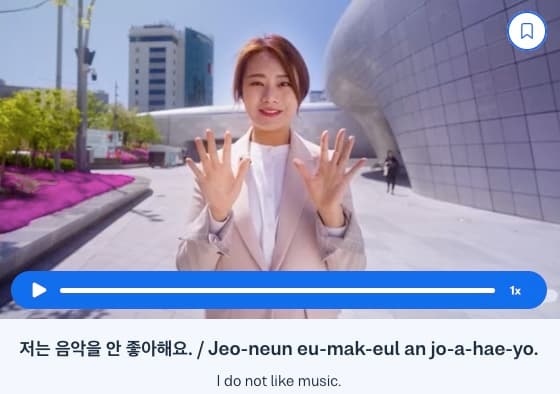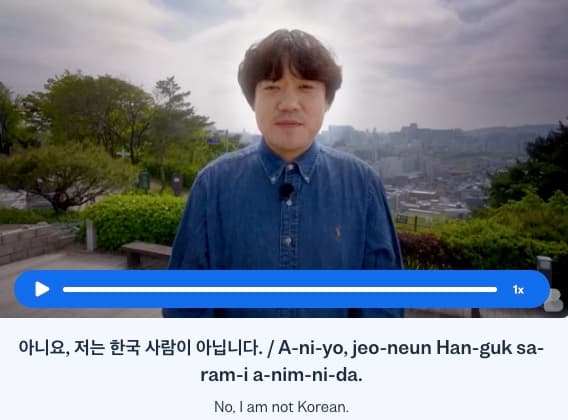How to Say ‘No’ in Korean
Learn how to say no in Korean in different situations.
Author:

Keehwan Kim
‘No’ is a simple, yet a very important word in any language. Not being able to say ‘no’ can sometimes make our lives difficult, so knowing how to say ‘no’ is an extremely important language skill. In this article, we will go over different ways of saying ‘no’ in different situations
The basic ‘no’ in Korean
At its basic level, we can say ‘no’ in two ways, depending on how formal we want or need to be.
2 Ways of saying ‘no’ in Korean
| Korean | Pronunciation | Formality |
|---|---|---|
| 아니 | [a-ni] | casual |
| 아니요 | [a-ni-yo] | polite |
Two most basic ways of saying ‘no’ are 아니 and 아니요. 아니 is the casual form, so we mainly use 아니 when we are saying ‘no’ to close friends. 아니요 is the polite form, so we say 아니요 when speaking to those with seniority, and when we want to be more formal and respectful.
Understanding 아니
아니 as ‘not’
아니 and 아니요 are interjections, so we use them as ‘no’. However, 아니 can also be used as an adverb, so it means ‘not’, and just like the English word ‘not’, we can use 아니 with verbs and adjectives to express negation. What that means is that when we want to say ‘I do not like this’, we use 아니 with the verb like. When 아니 is used in this way, we usually use it in its shortened form 안.
저는 토마토를 안 먹어요. [Jeo-neun to-ma-to-reul an memo-geo-yo.] - I don’t eat tomatoes.
날씨가 안 좋아요. [Nal-ssi-ga an jo-a-yo.] - The weather is not good.
아니다 as ‘not to be’
아니다 is an adjective and it is the negative form of the verb ‘to be’, so it means ‘not to be’. So if we want to say ‘Iam nota student’, we use 아니다. Because 아니다 is an adjective, we can change its level of formality.
Formality of 아니다
| Korean | Pronunciation | Formality |
|---|---|---|
| 아닙니다 | [a-nim-ni-da] | Formal |
| 아니에요 | [a-ni-e-yo] | Polite |
| 아니야 | [a-ni-ya] | Casual |
Formal - 저는 학생이 아닙니다. [Jeo-neun hak-saeng-i a-nim-in-da.]- I’m not a student.
Polite - 저는 학생이 아니에요. [Jeo-neun hak-saeng-i a-ni-e-yo.] - I’m not a student.
Casual - 나는 학생이 아니야. [Na-neun hak-saeng-i a-ni-ya.] - I’m not a student.
Different ways of saying ‘no’
아니 and 아니요 are general words that mean ‘no’, but depending on what we are saying ‘no’ to, there are different words and phrases we can use.
No, I can’t
안 is a general word for ‘not’, and we generally use 안 to make verbs and adjectives into negative forms, but if we want to express not being able to do something, we use 못 with verbs. Below are some example sentences.
A: 내일 파티에 올 거야? [Nae-il pa-it-e ol geo-ya?] - Are you coming to the party tomorrow?
B: 못 가. [Mot-ga.] - No (can’t go)
가 is the casual form of 가다 meaning ‘to go’, and 못 가 literally means ‘cannot go’. We do often add 아니 in front of 못 가 and say.
B: 아니, 못 가. [A-ni, mot-ga.] - No, I can‘t go.
No, it’s not allowed
When someone asks for permission to do something, we can use the verb 되다. 되다 can mean ‘to be allowed’, so we can use 안 with 되다 to make the negative form and say that something is not allowed.
A: 이거 먹어도 돼요? [I-geo meo-geo-do dwae-yo?] - Can I eat this?
B: 안 돼요. [An dwae-yo.] - No. (You can’t.)
A: 여기 앉아도 돼? [Yeo-gi an-ja-do dwae-yo?] - Can I sit here?
B: 안 돼. [An dwae-yo.] - No. (You can’t.)
So when someone asks for permission to do something, we can respond with 안 돼 (casual) or 안 돼요 (polite) to say that something is not allowed. Quite often, we can use 아니 or 아니요 to say ‘not, it’s not allowed.
Casual - 아니, 안 돼. - No, it’s not allowed.
Polite - 아니요, 안 돼요. - No, it’s not allowed.
No, I don’t want to
싫다 can mean to dislike, or unwilling, so when someone asks if we want to do something, we can use 싫다 to say that we don’t want do something, but it’s generally translated to mean ‘no’.
A: 아이스크림 먹을래요? [A-i-seu-keu-rim meo-geul-le-yo?]- Do you want to have ice cream?
B: 싫어요. [Si-reo-yo.] - No. (I don’t want to.)
A: 바닷가에 갈까? [Ba-da-kka-e gal-kka?] - Do you want to go to the seaside?
B: 싫어. [Si-reo.] - No. (I don’t want to.)
싫어요 is the polite form and 싫어 is the casual form of 싫다. It is possible to just respond by saying 아니 or 아니요, but when we want to include the meaning of how we don’t want to do something, it’s more common to say 싫어 or 싫어요.
No, I don’t have
To say ‘I have’, we often use the verb 있다, but when we say ‘don’t have’, we don’t just add ‘안‘ in front of the verb 있다 like other verbs. Instead, we use 없다 which means ‘not to have’, and when someone asks if we have something, instead of using 아니 or 아니요, we tend to use 없어 or 없어요.
A: 현금 있어? [Hyeon-geum i-sseo?] - Do you have cash?
B: 없어. [Eop-sseo.]- No. (I don’t have.)
A: 내일 계획 있어요? [Nae-il get-hoek i-sseo-yo?] - Do you have plans tomorrow?
B: 없어요. [Eop-sseo-yo.] - No. (I don’t have.)
없어 is the casual form and 없어요 is the polite form. We can also use 아니 or 아니요 with 없어 or 없어요. So we can say.
Casual - 아니, 없어. - No, I don’t have.
Polite - 아니요, 없어요. - No, I don’t have.
Remember to use the casual words with other casual words, and polite words with other polite words.
Polite ways of saying ‘no’
‘No’ is a simple word, and also can be quite a direct word, and when we decline people’s invitation or offer, it can hurt the other people’s feelings if we only say ‘no’. In these situations, we want to say ‘no’ in a more polite way, so let’s learn.
괜찮아요 (I’m okay)
To say ‘I’m fine’ or ‘It’s okay’, we use the adjective 괜찮다, and it’s polite form is 괜찮아요. When someone offers us something to drink, or asks us if we would like to sit, we can add 괜찮아요 with 아니요 and the combined phrase is a much more polite way of saying no.
A: 커피 하시겠어요? [Kep-pi ha-si-ge-sseo-yo?] - Would you like coffee?
B: 아니요, 괜찮아요. [A-ni-yo gwaen-chan-a-yo.] - No, I’m okay.
A: 여기 앉으시겠어요? [Yeo-gi an-jeu-si-ge-sseo-yo?] - Would you like to sit here?
B: 아니요, 괜찮아요. [A-ni-yo gwaen-chan-a-yo.] - No, I’m okay.
We can also use 괜찮아요 to form a phrase that is similar in meaning to ‘no, thank you.
A: 제가 도와드릴까요? [Je-ga do-wa-deu-ril-kka-yo?] - Can I help you?
B: 고맙지만 괜찮아요. [Go-map-ji-man gwaen-chan-a-yo.] - No, thank you. (Thank you, but I’m fine.)
A: 커피 하시겠어요? [Kep-pi ha-si-ge-sseo-yo?] - Would you like coffee?
B: 고맙지만 괜찮아요. [Go-map-ji-man gwaen-chan-a-yo.] - No, thank you. (Thank you, but I’m fine.)
고맙지만 combines 고맙다 (to be thankful) with 지만 (but), so the combined form 고맙지만 means ‘thank you, but’, and we can then add 괜찮아요 to say ‘thank you, but I’m fine’.
죄송하지만… (I’m sorry, but…)
When we want to decline someone’s request or invitation, we often use 죄송하지만 which means ‘I’m sorry, but’. This phrase combines 죄송하다 (to be sorry) with 지만 (but), and the combined form 죄송하지만 means ‘I’m sorry, but’. We can also form a similar phrase with 미안하다 (to be sorry), so 미안하지만 has the same meaning as 죄송하지만.
After 죄송하지만, we can use various phrases we learned to say we can’t do something, something is not allowed, or that we don’t have something.
죄송하지만 못 가요. [Joe-song-ha-ji-man mot ga-yo.] - I’m sorry, but I can’t go.
죄송하지만 안 돼요. [Joe-song-ha-ji-man an dwae-yo.] - I’m sorry, but it’s not allowed.
죄송하지만 없어요. [Joe-song-ha-ji-man eop-seo-yo.] - I’m sorry, but I don’t have.
Here’s how you can use these phrases in dialogues.
A:내일 결혼식에 올 거예요? [Nae-il gyeol-hon-sig-e ol geo-ye-yo?]- Are you coming to the wedding tomorrow?
B:죄송하지만 못 가요. [Joe-song-ha-ji-man mot ga-yo.]- I’m sorry, but I can’t go.
A:여기 앉아도 돼? [Yeo-gi an-ja-do dwae-yo?]- Can I sit here?
B:죄송하지만 안 돼요. [Joe-song-ha-ji-man an dwae-yo.]- I’m sorry, but it’s not allowed.
A:현금 있어요? [Hyeon-geum i-sseo?]- Do you have cash?
B:죄송하지만 없어요. [Joe-song-ha-ji-man eop-seo-yo.]- I’m sorry, but I don’t have.
Wrapping up
As simple as it may be, there are different ways of saying ‘no’ in Korean depending on what we are saying no to, and how polite and respectful we want or need to be. So if you find yourself in a situation where you are having to say ‘no’ to a pesky sales person, remember what you learned in this article. You can be polite as you say ‘no’, and it will make you trip in Korea a little more stress free.
AUTHOR

Keehwan Kim
Newlanguages


